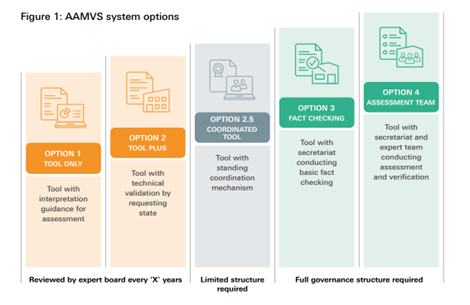Implementation Phase I
Assessing the feasibility of an AAMVS
In Phase I of the project, AMAT conducted a feasibility study for establishing an Arms and Ammunition Management Validation System (AAMVS). This effort was supported by an Expert Working Group (EWG) comprising of relevant practitioners and policy experts from 7 states, 5 international and regional organisations, and 4 non-governmental organisations. The steps for the feasibility assessment consisted of:
-
Conducting background research on the technical, political, legal, and economic considerations for the AAMVS
-
Defining the technical and operational parameters
-
Extensive global outreach and stakeholder analysis
-
Consolidating the findings from the assessment
Throughout phase I, AMAT held 4 EWG meetings and over 50 formal and in§formal Key Stakeholder Interviews with various experts and stakeholders, in addition to regular briefings to and meetings with the European Union’s Council and European External Action Service EEAS). The input and feedback from the EWG and the interviews were integrated in the feasibility study to answer the 7 questions indicated in the table below. The feasibility study concluded that there was an interest and benefit in creating an AAMVS. Its potential design was also found feasible on several political, operational and legal dimensions.
Initially, the intention behind the development of an AAMVS was for the design of a “certification” scheme for a state’s capability to manage arms and ammunition based on international guidelines and best practices. However, the feasibility study concluded some challenged at the operational level due to concerns of confidentiality and security, but also given the voluntary nature of the AAMVS. The system must provide an added value for importing states while exporting states should encourage its use. Nonetheless, the feasibility study concluded that a modular approach in assessing various components of a Small Arms and Light Weapons (SALW) and ammunition management system could allow to follow the International Standardization Organisations (ISO) methods in “conformity assessments”. Also, the AAMVS could be integrated in existing political international and regional instruments to help their implementation (e.g. Arms Trade Treaty and the UN Program of Action on SALW, ECOWAS Convention on SALW, Nairobi Protocol).

Summary of findings of feasibility study
In October 2021, GICHD-AMAT presented the results of the feasibility assessment to the European Union, along with a proposal for the next steps. Consequently, the European Union authorised the continuation of the project into the design phase (Phase II) via CFSP 2021/2075 amending CFSP 2020/979.
Implementation Phase II
Developing the plan for an Arms and Ammunition Management Validation System
On 25 November 2021, the European Union approved the continuation of the project into its second phase. Phase II of the implementation of the Council Decision involved developing a validation “system”, detailing the system owner governance requirements and designing a plan to develop the system. It also involved extensive outreach efforts aimed at bringing stakeholders from across the globe into the AAMVS design discussions. It ended with the development of three outputs which were presented and validated during a final workshop in November 2022 with the EWG:
-
Self-assessment tool which consists of a methodology for assessing arms and ammunition management capabilities
-
System Options which explore validation options and system requirements to determine the best fit
-
Proposed path forward “Roadmap” based on analysis explaining how the AAMVS should be developed in the following phase

Photo of EWG from final validation workshop in Brussels
The development of a self-assessment tool was an important step towards creating the AAMVS. The tool provides a standardised approach to analysing the capability of a state’s armed forces to effectively manage their stockpiles. It evaluates the SALW and ammunition management system of a state based on the International Ammunition Technical Guidelines’ (IATG) Capability Enabling Lines (CELs) which assesses nine different categories: normative frameworks, Safety, Security, Organisational, Personnel, Training, Infrastructure, Finance and Material Acquisition. It also enables this to be achieved without the resources and levels of cooperation to conduct on-site assessments. In addition, this phase of the project saw the development of a path for creating the ‘system’ component of the AAMVS. The path adopts a measured approach that seeks to tailor and pilot a regional AAMVS while promoting the system not only to other regions but also globally. Between the five proposed governance options for the AAMVS, meetings with experts and stakeholders have revealed a preference for a “limited” governance structure which allows to coordinate the conduct of self-assessments and their verification by standing mechanism as seen in the figure below:

AAMVS System Options
This phase moved the AAMVS concept from theory into practice. The tool can now be utilised and, once tested, will be ready to support national efforts to examine stockpile management capabilities as part of their diversion risk assessments. It can therefore already serve as a valuable tool for states wishing to incorporate it into their export licensing processes. The outputs of the second phase offered a clear possible pathway for creating a multinational AAMVS – one that has already demonstrated its potential to achieve greater efficiencies in the transfer processes of both importing and exporting states. A number of challenges remain before an AAMVS system becomes feasible; however, the path forward has become clearer, and, with increased participation from key stakeholders, the creation of a voluntary validation system of arms and ammunition management practices is a possibility. Based on the final outputs and the proposed way forward presented to the European Union, on 35 November 2021, the initiation of Phase III was approved through Council Decision (CFSP) 2022/2275.
The executive summary of the Phase II report can be accessed here.
